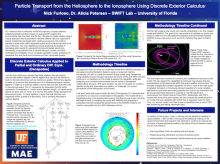Utilizing Discrete Exterior Calculus for Particle Transport from the Heliosphere to the Ionosphere
Nicholas
Furioso
Myself
Poster
Our research aims to efficiently model the trajectory of radiative particles and their impact on spacecraft throughout the environments near the Earth and the Sun. We plan to create models using a unique approach that is grounded in discrete exterior calculus. Opposed to typical models that are based within continuous calculus, this method expects to work better within applicable space environments that tend to be less continuous. This proposal plans to exploit the efficient nature of discrete exterior calculus in complex space environments to calculate accurate outputs quickly. Our main objectives include predicting the impact of damaging solar events for spacecraft and ground-based electronics, decreasing computational time of particle transport models, and after verification and validation of our increased capability models, analyzing the respective Sun and Earth environments and their convoluted physics. This is especially true near the Sun, as we will compare Parker Solar Probe (PSP) observational data to our validated model to look at any differences we see, and analyze why those differences occur. To predict solar event impacts, we have chosen to verify our model with the Nowcast of Aerospace Ionizing Radiation System (NAIRAS), a particle transport model that specializes in dosage rates of radiation for spacecraft, aircraft and its passengers. This research ultimately aims to explore which aspects of the underlying physics can be improved to better model particle transport.

Poster PDF
Poster category
Ionosphere and Thermosphere Research and Applications
Poster session day
Poster location
33
Meeting homepage